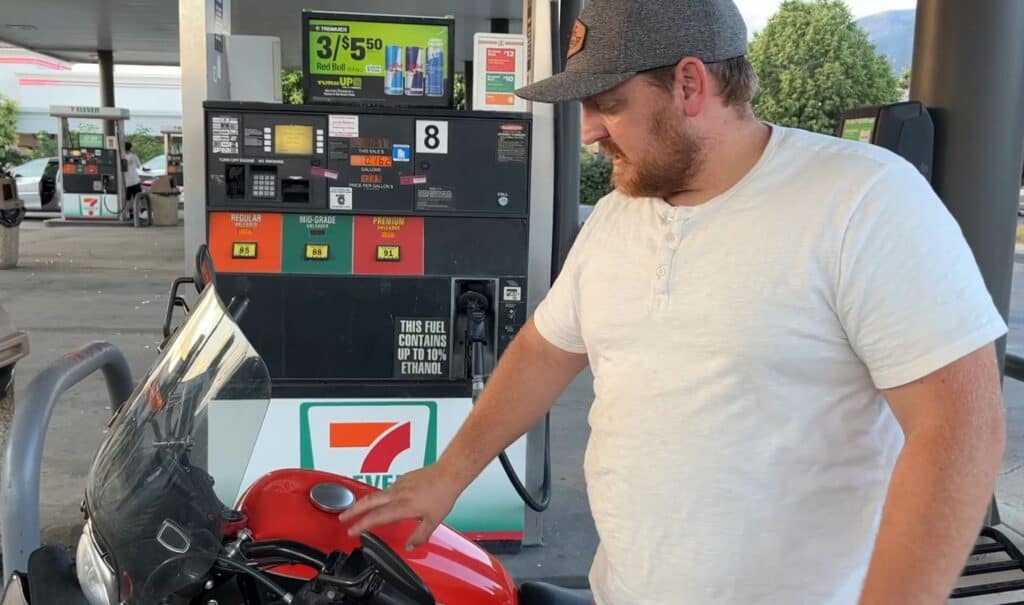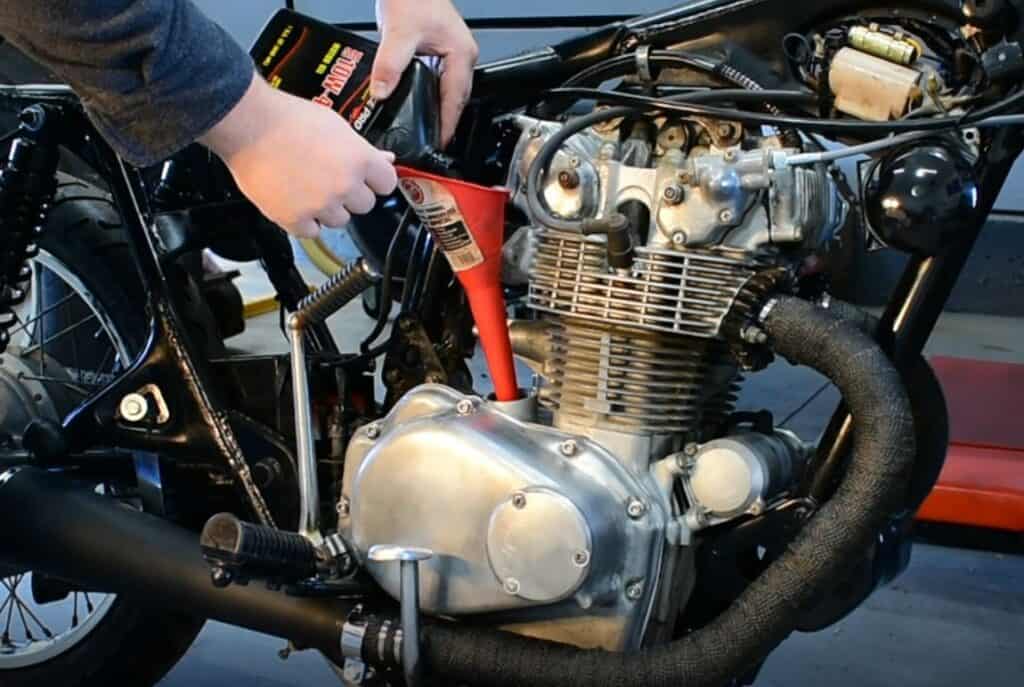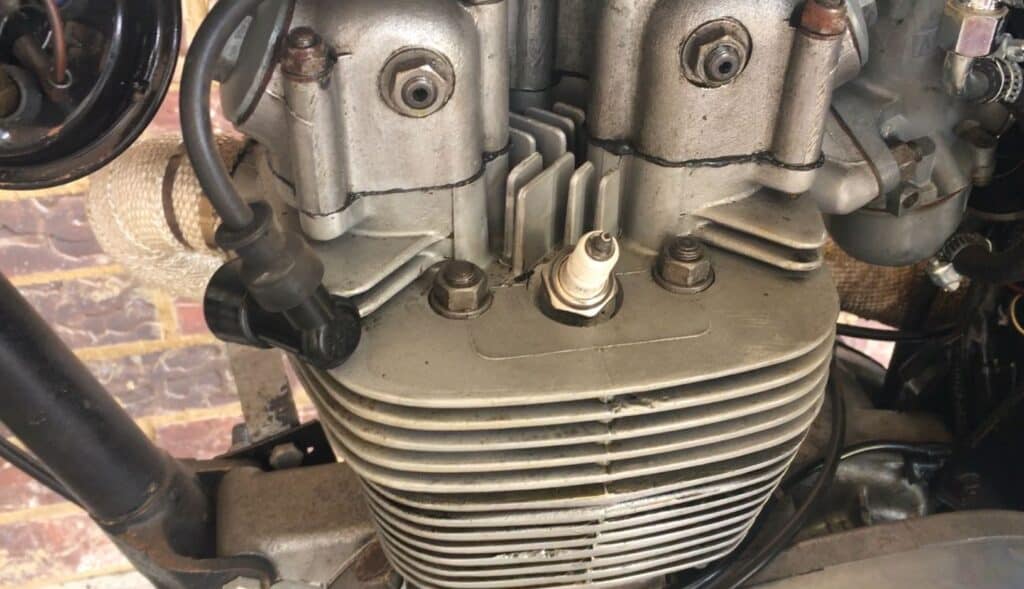
Measuring fuel mileage is an experiment in physics. There are a lot of reasons for a particular motorcycle’s fuel economy. However, there are some basics to take into consideration to gain a better understanding of fuel efficiency.
The 7 best ways to make your motorcycle more fuel efficient include:
- Track your mileage over time
- Be easy on the throttle
- Keep cruising speed to 65 mph
- Minimize idling time
- Keep up on regular maintenance
- Adjust brakes properly
- Ensure tires are inflated properly
Generally speaking, a smaller engine will consume less fuel by volume. This is why motorcycles are usually more efficient than cars. However, a small engine doesn’t always mean more miles per gallon. The gearing of the transmission and rear sprocket and the shift points play into how well the motorcycle can save fuel. While motorcycles are usually sleek and small, the rider usually isn’t as aerodynamic which causes extra drag.
7 Tricks To Getting Better Mileage

There are a lot of things that affect your fuel mileage and a lot of it comes down to how you ride. I first started riding about 13 years ago when I was in college. I tried everything I could to save some money. My father-in-law was the same way and had been riding for 50+ years. These were his suggestions that I tried out personally and found that they do, in fact, help with fuel mileage on motorcycle.
Here are some tips to bump up your fuel efficiency:
1. First, keep track of your mileage. In all reality, this is a science experiment and to be effective and unbiased in an experiment you need to track data. I hated doing this at the beginning, but it really helps put things into perspective.
This will give you concrete evidence about your fuel economy. Track the mileage on a sheet of paper or spreadsheet on an electronic device. Doing so over time will give you a look into your overall fuel mileage. Take notes of different riding conditions per fill-up to account for those conditions that affect mileage.
Whenever you fill up, record the mileage. Some bikes will have a trip meter, which can be a good way to track the miles per fill-up. Make sure to reset the trip meter the same way every time to ensure the margin for error is minimized. Similarly, make sure to fill up the tank consistently the same way every time.
2. Second, easy on the throttle. Heavy acceleration is bad for fuel economy because you are pouring gas into the engine to get higher performance. To understand this, look at the RPM’s compared to speed or distance traveled. In the lower gears, you are having more RPMs per speed compared to the higher gears. Gradually bring the bike up to speed to improve fuel economy.
Some larger bikes have more low-end torque. With more torque at acceleration, bigger bikes require fewer RPMs through lower gears. These cruiser bikes are also geared to keep a lower RPM at highway speeds to keep fuel economy lowered. This doesn’t always mean a big bike gets better mileage, but it can keep up when driven conservatively.
3. Next, watch your speed. This is related to easing into acceleration. Generally speaking, by lowering the speed at cruising, the bike is using less fuel over the same distance with the compromise being time. There is theoretically a “sweet spot” between engine power and speed that equals optimal efficiency. This can be difficult to nail down, so try a few different speeds to see what works best for you.
This is also where engine size plays a part. While larger bikes have larger engines, they also typically produce more torque. Likewise, a smaller engine will need to rev higher to maintain higher speeds. Consider your bike size and find a speed that works for you. This plays into keeping track of your mileage and what variables are changed.
4. The next tip is to minimize idling time. Idling is often required to warm up the engine and that’s unavoidable. However, being conscious of how long or how often the bike idles and taking action to minimize idling time will boost your MPG.
Idling equals ZERO miles per gallon. The engine is consuming fuel without going anywhere. This zero drags the average down. In town, there are stop signs, stop lights, traffic, and so on, where you are not moving with the engine running. This is why in-town mileage is often lower than highway mileage.
5. Next, keep up on maintenance. There is always some inherent mechanical resistance in the engine, transmission, chain, and so on. Oils are used to minimize that resistance, but as the oil breaks down or becomes dirty, the effective lubrication also breaks down. This resistance makes the engine work harder requiring more fuel.
Keeping up on maintenance is the best shot for minimizing internal resistance. Keep engine oil fresh and at the proper level. Maintain transmission gear oil in addition to any other gear oil, such as a rear differential on shaft-driven bikes. On chain-driven bikes, make sure your chain is clean and rust-free. Don’t overlook the air filter since a dirty air filter will choke out the engine.
6. Brakes are designed to resist the inertia of the bike when applied. However, brakes often can drag and cause resistance when not applied. This can be due to a stuck cylinder, bad brake fluid, or having the brakes installed incorrectly. Inspect your brakes for any signs of dragging and make repairs as needed.
7. Finally, tires are related to maintenance, but more directly affect mileage. Since this is where the power from the bike is transferred to, tires can have a direct impact on fuel economy. If a tire is underinflated, it causes unnecessary road force drag.
Side note: underinflation will also shorten the life of your tires. Use manufacturer-recommended pressures as a baseline. These pressures are often displayed on a sticker somewhere on the bike frame.
There is some room for “tuning” your tire pressure. Theoretically, by overinflating the tire, the contact surface of the tire is minimized and therefore the drag is minimized. However, this is not recommended as overinflating can shorten the life of a tire as well. The handling may also be affected, so be cautious about overinflating.
Possible Reasons For Poor Fuel Economy

There may be instances in which you find your motorcycle isn’t doing as good on fuel as it once was. Perhaps the MPG’s have gradually gone down or sometimes it seems to drop overnight. In either case, there is a problem that requires attention and repair.
Here are a few steps to figuring out a drop in MPG:
- Check the basics. Do any fluids need to be topped off or changed? Check tire pressures. Are they too low? Does the air filter need replacing? Is there anything else that has been worked on or is otherwise different?
- Bad spark plugs. Fouled plugs won’t spark hot enough causing some fuel to go unburned. If you find your spark plugs are in poor condition, investigate further and you might find a root cause. If they need to be replaced, put some new ones in and monitor the effect on the MPG.
- Fuel leak. Fuel leaking onto the ground and not being burned in the engine drastically affects the fuel economy. Use extra caution when addressing these issues as gas is highly flammable and emits toxic vapors. Some culprits could be cracked hoses, bad fittings, leaking petcock, or leaking injectors on fuel-injected engines.
- Dragging brakes. As mentioned above, dragging brakes can cause unwanted resistance on the engine. Improperly installed brakes, a stuck brake cylinder, or bad fluid can cause this.
If you have an older motorcycle, there is the possibility of internal engine problems. Issues like carbon buildup on valves and pistons to leaking seals affect MPG. However, these issues typically require engine disassembly and cleaning.
We have a whole article dedicated to discussing why a motorcycle gets bad gas mileage. You can read that by clicking here.
What Should My Fuel Mileage Be?
A general range for motorcycle fuel economy is 30-40mpg. Some bikes can push more, depending on the variables discussed above. There are a lot of resources for estimating what you should be getting. While the internet is full of opinions, there are some websites with objective data that provide useful information. One such site is fuelly.com, which collects data from all types of vehicles, years, makes, and models.
If you are in the market for a fuel-sipping motorcycle, websites like fuelly.com are a good way to research the best options. They have a top 10 or you can search by year, make, and model. Coupling this with other research can help weed out your options.
If you already have a motorcycle, buying a new one just for better fuel mileage isn’t always the best option. You can find what other bikes similar to yours get for fuel economy, but remember that yours might be different due to the reasons discussed above.
A good strategy to figure out what yours could be is to find what range it should be in and then start diligently tracking what you’re getting. This will help you pinpoint what you really can achieve.
Conclusion
Making your motorcycle more fuel-efficient is both beneficial for your wallet and the environment. By implementing the seven strategies discussed in this article – tracking mileage, easy throttling, speed mindfulness, maintenance, decreasing idling time, adjusting brakes, and ensuring proper tire inflation – riders can significantly enhance their motorcycle’s fuel efficiency.
Are there any other ways you can enhance your fuel mileage on your motorcycle that wasn’t listed in this article?
